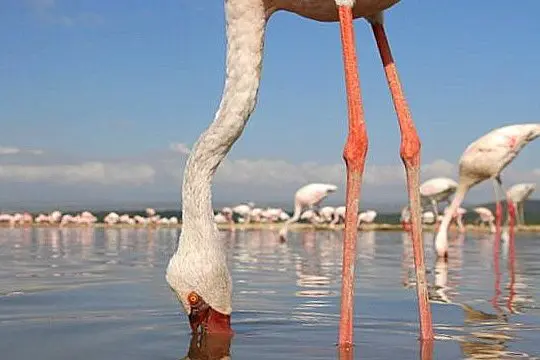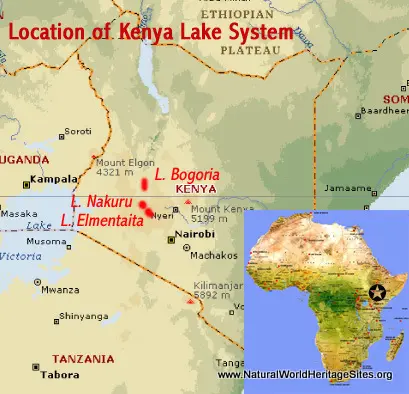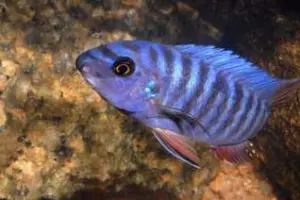EXPLORE KENYA’S LAKE SYSTEM IN THE GREAT RIFT VALLEY with this slideshow, check the location map and get all the facts and information below.
For slideshow description see right or scroll down (mobile). Click to view slideshow
Values: The Kenya Lake System in the Great Rift Valley covers three of Africa’s most spectacular lakes (Lakes Nakuru, Bogoria and Elmenteita), set in the floor of the eastern arm of the Great Rift Valley. This is an area where the Earth is splitting apart, and the lakes are nestled in the valley floor in a landscape dominated by dramatic escarpments and punctuated by volcanic cones, steaming fumeroles and hot springs. Straddling the equator, these three alkaline ‘soda’ lakes are the setting for one of the Earth’s greatest wildlife spectacles – the feeding and movement of massive flocks of lesser flamingos. Numbering up to 4 million birds, they move between the three lakes (and further afield) in response to episodic and seasonal changes in the abundance of the algae on which they feed. A comprehensive review of the world heritage values of the Kenya Lake System in the Great Rift Valley is provided below, together with details of the area’s conservation status and the threats it faces.
REVIEW OF WORLD HERITAGE VALUES: The specific attributes which qualify the Kenya Lake System in the Great Rift Valley for world heritage status can be summarised as follows:
Outstanding natural beauty: The three lakes, each with its own characteristic features, are areas of outstanding natural beauty. Flanked by the towering walls of the Great Rift escarpments, they nestle in the valley floor, their open waters set against the thorn-tree savannas, forests and marshes that surround them. The landscape is punctuated by volcanic cones, hot springs and gushing geysers. Massive congregations of flamingos and other birds and a diverse array of large mammals inhabit the area, creating an unmatched experience of raw nature, truly one of the great wonders of the natural world.
Exceptional geo-morphological features of the Great Rift Valley: Africa’s Great Rift Valley is one of the world’s most distinctive geo-morphological features, cutting through the continent from the Red Sea to southern Mozambique along two parallel fault lines. The Kenya Lake System in the Great Rift Valley includes a representative sample of some of its main geo-morphological features, including the three alkaline lakes, parts of the rift escarpment, and a range of volcanic features and associated geothermal manifestations (geysers, fumeroles and hot springs).
Extraordinary soda lake ecosystem processes and trophic dynamics: The three lakes are generally shallow, alkaline lakes with relatively small catchments and no surface outlets. Straddling the equator at altitudes of around 1,500m they are subject to high rates of evaporation and marked fluctuations in water levels. The alkaline lake waters support a prolific growth of green algae (Spirulina platensis), the main food of the itinerant Rift Valley population of lesser flamingos. The alkaline Rift Valley lakes are among the world’s most productive ecosystems and, although these harsh environments are relatively species-poor, they feed extraordinary numbers of birds. They provide important insights into our understanding of trophic dynamics and ecosystem processes.
Exceptionally diverse bird fauna, including rare and endangered species: All three lakes within the Kenya Lake System in the Great Rift Valley are internationally recognized as Important Bird Areas and listed as Ramsar Sites, on account of the numbers and diversity of birds, including many rare and endangered species. Records indicate as many as 480 bird species at Lake Nakuru, 450 species at Lake Elmenteita and 370 species at Lake Bogoria. These include 13 globally-threatened and 8 regionally-threatened species. Lake Elmenteita supports the region’s main breeding colony of Great White Pelicans (8,000 pairs) and there are globally important populations of Black-necked Grebe, African Spoonbill, Avocet, Little Grebe, Yellow-billed Stork, Black-winged Stilt, Grey-headed Gull and Gull-billed Tern.
World’s largest congregations of lesser flamingos: Congregations of more than 1.5 million Lesser Flamingos have been counted at Lakes Nakuru and Bogoria, as they move between the ten ‘Flamingo Lakes’ of East Africa. Such congregations are globally unique and constitute one of the world’s most spectacular wildlife phenomena.
Crucial flyway for bird migration: The Great Rift Valley is of global significance as a migratory corridor for 500 million birds of 350 species which pass through the area en route between their summer breeding grounds in Eurasia and over-wintering sites in southern Africa. The lakes serve as over-wintering sites for large numbers of Palaearctic waders as well as being an important stop-over for birds on passage.
Diverse assemblage of mammals, including rare and endangered species: The lake shore habitats of the Kenya Lake System in the Great Rift Valley, particularly those of Lake Nakuru National Park, support a diverse assemblage of large mammals, including important populations of endangered species such as black (and southern white) rhino, Rothschild’s giraffe, lion, cheetah and leopard.
CONSERVATION STATUS AND PROSPECTS: The three lakes which make up the Kenya Lake System in the Great Rift Valley are subject to pronounced and unpredictable fluctuations in rainfall, water levels and alkalinity – factors which determine the movements of flamingos and other birds between these lakes, and others beyond. Water-bird counts over the past 20 years suggest that bird populations are stable, but there are uncertainties over the future of the lakes as the catchment areas come under progressively more intensive land use and increasingly large volumes of water are used upstream.
MANAGEMENT EFFECTIVENESS: There is little information on the effectiveness of current management in addressing threats to the property, but it was considered adequate at the time the nomination for the world heritage site was evaluated in 2010. Management within the three reserves is well-planned and adequately resourced, but there is uncertainty over the extent to which land degradation, deforestation and upstream water use are being curbed in the lake catchment areas (which are experiencing high rates of population growth and development pressure).
REVIEW OF CONSERVATION ISSUES AND THREATS: The following issues represent specific threats to the ecology, conservation and values of the Kenya Lake System in the Great Rift Valley.
Degradation of lake catchment areas, soil erosion and siltation: The catchment areas of the three lakes are relatively small (930 km2, 1,800 km2 and 630 km2 for Lakes Bogoria, Nakuru and Elmenteita respectively), and subject to rapid deforestation, over-grazing and expansion of agriculture. Forest cover in Lake Nakuru’s catchment was reduced from 47% in 1970 to just 26% in 1986, and nearly half the catchment is now under cultivation. These land-use changes are resulting in increased soil erosion, run-off and siltation.
Use of water from upstream catchment areas and groundwater aquifers: Small irrigation dams have been constructed on rivers flowing into the lakes and river flows have reduced substantially in recent years. At Lake Elmenteita there is currently little water flowing into the lake because farmers use most of the water for irrigation upstream. Given the rate of population increase and intensification of land use in the area, this trend seems likely to accelerate, unless deliberate steps are taken to curb water abstraction.
Pollution and eutrophication: Pollution of the lakes’ water is a problem, especially affecting inflows from the growing agricultural and industrial town of Nakuru (population 500,000). Until recently, treatment of wastewater entering the lake from the town was inadequate, but the municipality is now taking measures to reduce this threat and an expanded sewage treatment works has been commissioned. In the wider catchments, intensification of agriculture and increased use of fertilizers may be increasing the nutrient load of inflowing waters and could lead to eutrophication.
Tourism pressure: Lake Nakuru National Park attracts 300,000 visitors annually, and this is creating some pressures related to off-road driving, over-crowding and waste management. Lake Nakuru is one of Kenya’s most popular tourist destinations, and management of tourism impacts is generally good. At present tourism exerts little pressure on either of the other two lakes and is a force for their conservation.
Small size and ecological isolation: The three lakes within the Kenya Lake System in the Great Rift Valley are quite small (40 km2, 38 km2 and 25km2 for Lakes Nakuru, Bogoria and Elmenteita respectively) and although the world heritage site includes surrounding lakeshore habitats (totalling 217km2), the three areas are isolated from one another. The primary functional linkages between them are associated with their shared role in supporting the lesser flamingo and other bird populations. The terrestrial components of the three lakes are not large enough to support viable populations of many species that would naturally occur in the area.
Ecological change in other Rift Valley lakes: The lesser flamingos and other birds move great distances between the ten ‘flamingo lakes’ of the eastern Rift, and beyond, so are vulnerable to ecological changes or pollution of any of the other lakes. There is already a major soda factory on Lake Magadi, and a similar development has been mooted for Lake Natron (which serves, critically, as the main breeding site for lesser flamingos).
Invasive alien species: There is little available information on the occurrence of invasive alien species, but the management plan for Lake Bogoria recognizes that the reserve is suffering a ‘proliferation of invasive species’. It is noteworthy that the ecology and trophic dynamics of Lake Nakuru has been fundamentally altered as a result of the introduction of the suitably-adapted cichlid fish, (Oreochromis alcalicus grahami) from another of the alkaline soda lakes, Lake Magadi. Prior to this introduction there were no fish in the highly alkaline waters of Lake Nakuru, and its introduction now supports a diversity of fish-eating birds that were not there previously (including the pelicans which nest at Lake Elmenteita).
Habitat change induced by over-abundant animal populations: Lake Nakuru National Park is entirely surrounded by a 74-km electric fence that prevents animal dispersal, and has allowed large mammal populations to increase to a level where serious ecological imbalances are becoming apparent. For example, giraffe (now a population of 170 individuals, bred from 16 individuals that were re-introduced from western Kenya some years ago) are beginning to destroy the Acacia woodland by debarking the trees excessively.
Livestock grazing pressure: There are concerns about livestock grazing at Lakes Bogoria and Elmenteita, where cattle and goats graze along the lakeshore habitats, causing increased rates of erosion, run-off and siltation.
Mineral exploitation: Small-scale extraction of soda and sand on the eastern shores of Lake Elmenteita is not a major threat at present, but any expansion of these operations could have a significant impact on the site.
Climate change: Whilst the Kenya Lake System in the Great Rift Valley has demonstrated extreme resilience to fluctuations in climate and water levels, the possible future impacts of climate change are unpredictable.
Infrastructure development: The lakes lie astride the main ‘transport and infrastructure corridor’ between the port of Mombasa and countries to the north-west (Uganda, Rwanda, Sudan and eastern Congo). As this corridor develops further, and branches to the north and south are developed, it is likely to further disrupt landscape connectivity, particularly for large mammals. A particular concern is that any mis-placed power transmission lines could kill large birds on passage, as well as flamingos as they move between the lakes.
Oil and gas exploration and development: Although there is no oil or gas exploration activity presently underway within the world heritage site, there have been major recent oil discoveries in other parts of the Rift Valley, including the Lake Turkana Basin, less than 200km to the north of Lake Bogoria. These finds are stimulating further exploration activity elsewhere in the Rift Valley and part of the property (at Lake Bogoria) is included within Tullow Oil’s exploration concession.
Links:
Google Earth
Official UNESCO Site Details
UNEP-WCMC Site Description
IUCN Conservation Outlook
Birdlife Nakuru IBA
Slideshow description
The slideshow provides a comprehensive overview of the Kenya Lake System in the Great Rift Valley, showing its lakes and shoreline landscapes, wildlife habitats, plants and animals. It features vast flocks of flamingos and other wetland birds as well as rhinos and other threatened species, while also illustrating some conservation management issues, local community livelihoods and some of the visitor facilities and typical experiences.
Factfile
Website Category: Lakes, Freshwater Wetlands & Glaciers
Area: 320 km2
Inscribed: 2011
Criteria:
- (vii) aesthetic ;
- (ix) evolutionary processes ;
- (x) biodiversity





